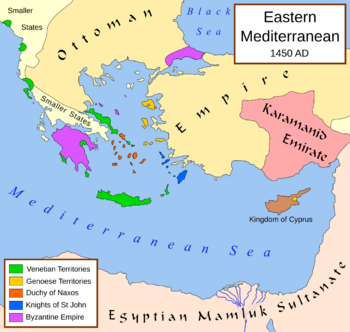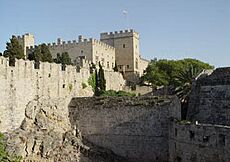Hospitaller Rhodes facts for kids
Quick facts for kids
Hospitaller Rhodes
|
|||||||||||
|---|---|---|---|---|---|---|---|---|---|---|---|
| 1310–1522 | |||||||||||

Rhodes and other possessions of the Knights Hospitallers of St. John.
|
|||||||||||
| Capital | Rhodes | ||||||||||
| Religion | Roman Catholicism | ||||||||||
| Government | Elective monarchy | ||||||||||
| Governor | |||||||||||
| Historical era | Middle Ages | ||||||||||
|
• Hospitaller occupation of Rhodes
|
1310 | ||||||||||
| 22 December 1522 | |||||||||||
|
|||||||||||
| Today part of | Greece | ||||||||||
The history of Rhodes under the Order of Saint John tells the story of the Knights Hospitaller on the island of Rhodes. From 1310 to 1522, Rhodes was their own independent territory. The Knights first came from Palestine and then Cyprus. On Rhodes, they had their own government and rules. The first leader, called a Grand Master, was Foulques de Villaret from France.
Contents
The Knights Find a New Home
After the Kingdom of Jerusalem ended in 1291, the Knights Hospitaller needed a new base. They moved to the Kingdom of Cyprus. However, they found themselves getting too involved in Cypriot politics. They wanted their own land where they could make their own decisions.
Choosing Rhodes
The Knights' leader, Guillaume de Villaret, decided that the island of Rhodes would be perfect. Rhodes was part of the Byzantine Empire at the time. His successor, Foulques de Villaret, worked to make this move happen.
He had some disagreements with Henry II, the king of Cyprus. These issues made the Knights want their own place even more. So, Villaret decided to move the Order to Rhodes.
Taking Control of Rhodes
Villaret traveled to Avignon and Paris to get permission and help. He spoke with Pope Clement V and King Philip IV of France. The Pope agreed to the plan.
In September 1308, a fleet of ships set sail from Brindisi. The Byzantine emperor, Andronikos II Palaiologos, did not want the Knights on Rhodes. He sent soldiers to defend the island. But the Knights fought them off.
After more than four years of fighting, the city of Rhodes finally gave up. This happened on August 15, 1310. The Knights also took control of nearby islands. They even gained the port of Halicarnassus and the island of Kastellorizo.
Life on Rhodes
On Rhodes, the Knights were organized into groups called "langues." Each langue represented a different region or language. For example, there was an English langue. Each langue had a leader called a "baili."
In 1334, the Knights of Rhodes won a battle against Andronikos III Palaiologos and his Turkish allies. They fought in several other battles during the 14th century.
Defending Key Locations
In 1374, the Knights took over the defense of Smyrna. This city had been captured by a crusade in 1344. The Knights held Smyrna until 1402. That year, a powerful leader named Timur attacked and took the city.
On Rhodes, the Knights had to become very strong fighters. They often battled against Barbary pirates who attacked ships. They also faced two big invasions in the 15th century.
Building Strongholds
In 1402, the Knights built a strong fortress on the Halicarnassus peninsula. Today, this place is known as Bodrum. They even used stones from the ancient Mausoleum at Halicarnassus to build their castle. The Mausoleum was one of the Seven Wonders of the Ancient World. This new castle was called the Petronium.
The Final Siege
In 1444, the Mamluk Sultan of Egypt, Sayf ad-Din Jaqmaq, tried to invade Rhodes. The Knights successfully defended the island. Then, in 1480, the Ottoman Sultan Mehmed the Conqueror attacked. He had captured Constantinople in 1453 and now saw the Knights as a major target. The Knights held strong and defeated this invasion too.
The Fall of Rhodes
However, in 1522, a much larger force arrived. Sultan Suleiman the Magnificent led 400 ships and about 100,000 soldiers to Rhodes. Some sources say there were even 200,000 soldiers.
The Knights, led by Grand Master Philippe Villiers de L'Isle-Adam, had only about 7,000 fighters. Their strong walls were their main defense. The siege lasted for six months.
In the end, the Knights were defeated. The surviving Hospitallers were allowed to leave Rhodes and sail to Sicily. Even though they lost, both Christians and Muslims respected the bravery of Grand Master Phillipe Villiers de L'Isle-Adam. The Pope even called him a "Defender of the Faith."
Gallery
See also
- Hospitaller Malta
- List of Knights Hospitaller sites










